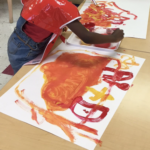In this painting unit, children will develop explore manipulating paintbrushes, creating marks and lines, and mixing colors.
Lessons
Materials and Tools
- 18”x 24” white paper 80#
- Red paint in soufflé cup
- Blue paint in soufflé cup
- Yellow paint in soufflé cup
- White paint in soufflé cup
- 1” brush
- 1/2″ brush
- Water in deli cup
- Sponge
- Tray
Objectives
How to support three-four year old students’ learning through art making:
- Use open ended materials.
- Generate invitations to explore.
- Teach concepts and skills at the same time.
- Work with 3-4 students at a time in the Art Center.
- Each child should have her own tray with supplies
- 5-7 minute engagement
5-20 minute work time
5-7 minute reflection


Credits
Written By:
Sassy Kohlmeyer, Director of Early Childhood Programs
and the Early Childhood team
Copyright © 2023 Studio in a School NYC LLC









